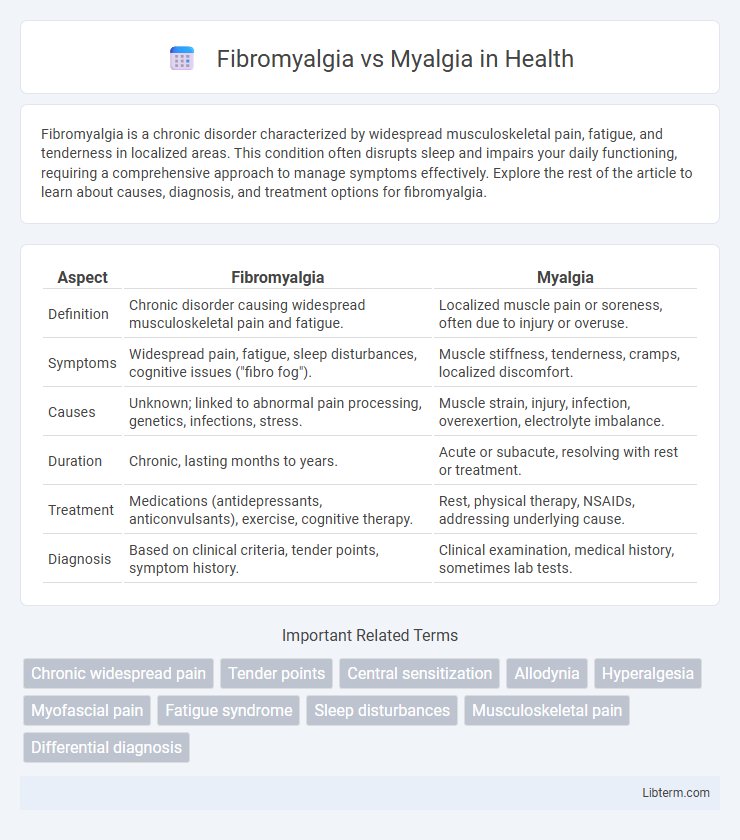Fibromyalgia is a chronic disorder characterized by widespread musculoskeletal pain, fatigue, and tenderness in localized areas. This condition often disrupts sleep and impairs your daily functioning, requiring a comprehensive approach to manage symptoms effectively. Explore the rest of the article to learn about causes, diagnosis, and treatment options for fibromyalgia.
Table of Comparison
| Aspect | Fibromyalgia | Myalgia |
|---|---|---|
| Definition | Chronic disorder causing widespread musculoskeletal pain and fatigue. | Localized muscle pain or soreness, often due to injury or overuse. |
| Symptoms | Widespread pain, fatigue, sleep disturbances, cognitive issues ("fibro fog"). | Muscle stiffness, tenderness, cramps, localized discomfort. |
| Causes | Unknown; linked to abnormal pain processing, genetics, infections, stress. | Muscle strain, injury, infection, overexertion, electrolyte imbalance. |
| Duration | Chronic, lasting months to years. | Acute or subacute, resolving with rest or treatment. |
| Treatment | Medications (antidepressants, anticonvulsants), exercise, cognitive therapy. | Rest, physical therapy, NSAIDs, addressing underlying cause. |
| Diagnosis | Based on clinical criteria, tender points, symptom history. | Clinical examination, medical history, sometimes lab tests. |
Understanding Fibromyalgia and Myalgia
Fibromyalgia is a chronic condition characterized by widespread musculoskeletal pain, fatigue, and tenderness in specific areas, often accompanied by sleep disturbances and cognitive issues. Myalgia refers to localized muscle pain caused by muscle injury, tension, or inflammation and is typically acute and short-lived. Understanding the differences in symptoms, duration, and underlying mechanisms is crucial for accurate diagnosis and effective treatment of fibromyalgia versus myalgia.
Key Differences Between Fibromyalgia and Myalgia
Fibromyalgia is a chronic disorder characterized by widespread musculoskeletal pain, fatigue, and tender points, whereas myalgia refers to muscle pain that is typically localized and linked to injury, overuse, or inflammation. Fibromyalgia involves central nervous system sensitization and often includes symptoms like sleep disturbances, cognitive difficulties, and mood disorders, contrasting with myalgia's predominantly physical and localized muscle discomfort. Diagnosis of fibromyalgia relies on criteria such as the widespread pain index (WPI) and symptom severity scale (SS), while myalgia diagnosis depends on clinical evaluation of muscle pain origin and related factors.
Common Symptoms of Fibromyalgia
Fibromyalgia is characterized by widespread musculoskeletal pain, fatigue, and sleep disturbances, which differentiate it from localized myalgia that typically involves muscle pain in specific areas. Common symptoms of fibromyalgia include tender points, chronic headaches, cognitive difficulties (often called "fibro fog"), and heightened sensitivity to pain. These symptoms often coexist with mood disorders, such as anxiety and depression, making fibromyalgia a complex, multifaceted condition.
Typical Symptoms of Myalgia
Myalgia primarily presents as muscle pain, tenderness, and stiffness, often localized to specific muscle groups or widespread depending on the underlying cause. Symptoms may include muscle cramps, weakness, and fatigue, which typically worsen with physical activity or sustained muscle use. Unlike fibromyalgia, myalgia does not usually involve the multiple tender points, sleep disturbances, or cognitive issues commonly seen in fibromyalgia patients.
Causes and Risk Factors
Fibromyalgia is caused by a combination of genetic predisposition, abnormal pain processing in the central nervous system, and environmental triggers such as stress or infections. Myalgia, muscle pain often linked to injury, overuse, or infections, results from localized muscle inflammation or strain. Risk factors for fibromyalgia include female gender, family history, and autoimmune disorders, while myalgia risk increases with physical activity levels, trauma, and certain viral illnesses.
Diagnosis: Fibromyalgia vs Myalgia
Fibromyalgia diagnosis relies on widespread pain lasting more than three months, tender points examination, and ruling out other conditions through blood tests and symptom evaluation. Myalgia diagnosis focuses on localized muscle pain, often identified through physical examination and patient history, with fewer specific diagnostic criteria. Laboratory tests and imaging are typically used to exclude underlying causes in both conditions.
Treatment Options for Fibromyalgia
Fibromyalgia treatment primarily involves a multidisciplinary approach including pharmacological options like pregabalin, duloxetine, and milnacipran, which target nerve pain and improve sleep quality. Non-pharmacological therapies encompass cognitive behavioral therapy, regular low-impact aerobic exercise, and physical therapy to reduce symptoms and enhance daily functioning. Lifestyle modifications such as stress management, adequate sleep, and dietary changes also play a critical role in managing fibromyalgia effectively.
Treatment Strategies for Myalgia
Treatment strategies for myalgia primarily involve addressing underlying causes such as muscle strain, overuse, or inflammation through physical therapy, pain relief medications like NSAIDs, and muscle relaxants. Incorporating regular stretching exercises and optimizing ergonomic practices can reduce muscle tension and prevent recurrence. In some cases, alternative treatments such as acupuncture, massage therapy, or trigger point injections may enhance symptom management and improve muscle function.
Living With Chronic Muscle Pain
Chronic muscle pain in fibromyalgia is characterized by widespread tenderness, fatigue, and sleep disturbances, affecting daily activities and quality of life more severely than localized myalgia. Managing fibromyalgia often requires a multidisciplinary approach, including medication, physical therapy, and lifestyle modifications to address central nervous system sensitization. In contrast, myalgia typically involves localized muscle pain from injury or strain, with treatment focused on rest, anti-inflammatory medications, and targeted physical therapy for symptom relief.
When to Seek Medical Advice
Seek medical advice for fibromyalgia if widespread musculoskeletal pain persists for more than three months, especially when accompanied by fatigue, sleep disturbances, and cognitive difficulties. In cases of myalgia, consult a healthcare provider if muscle pain is severe, does not improve with rest, or is associated with swelling, redness, or weakness. Early diagnosis and treatment can prevent complications and improve quality of life for both conditions.
Fibromyalgia Infographic

 libterm.com
libterm.com